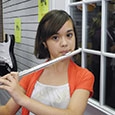Musicians often speak of instrument families, and the brass, woodwinds, and percussion sections, are often seen as hegemonic blocks of students, each requiring similar pedagogical approaches within their respective groups. In the brass world, there are a great number of commonalities that make this frame of reference useful. From trumpet to tuba, several pedagogical concepts can be spoken of uniformly.
The woodwind family of instruments is far more heterogeneous than the brass. Unlike the shared cup mouthpiece of all valved instruments, woodwinds encompass instruments with single reeds, double reeds, and even the cutting edge of the flute lip-plate. All of the woodwinds possess some fairly dissimilar challenges and techniques. One of the trickiest differences to the non-woodwind band director is the execution of vibrato: What is it, when should it be used, and how does it work on each of the woodwinds?
Vibrato
While everyone reading this article can identify vibrato when they hear it, it may be beneficial to speak of the technique in the widest terms. At the most basic level, vibrato is a continuous alteration in pitch or intensity of a note, intended to serve as a further beautifying element for the tone or as an expressive tool. Ideally, the performer should be capable of changing the vibrato to suit different musical ends: A quicker or slower vibrato or a more or less intense one can highlight differences of range, dynamic, tempo, or the like.
While the overall effect is virtually the same from instrument to instrument, the best technique to achieve the smoothest, most consistent, best-sounding vibrato varies. Older sources list many possibilities for achieving the desired ends including throat and lip vibrato. These and many other terms are misleading and outmoded (and often detrimental to long-term performance health). All of the woodwinds today are best served by utilizing either jaw or airstream vibrato.
Fundamentals First
While vibrato should be integrated into the performance-practice of many woodwind players at an early stage, certain factors should be achieved before introducing the concept. First, the airstream should be consistent and well-supported. Next, the embouchure should be stable and comfortable. Overall, the basics of tone production should be well-learned, and students should be producing a good quality, characteristic sound for a beginner. Vibrato can serve as the icing on the cake of a great sound, but it cannot fix a poor one. Further, if students have not yet achieved a stable airstream and embouchure, the premature introduction of vibrato can serve as a stumbling block. However, all other things being equal, most students can be introduced to the technique by the end of the first year of study.
Flute
Flutists use an airstream vibrato, a fluctuation in the intensity of the breath. To begin teaching this technique, have students say ho ho ho (à la a certain red-suited, bearded gentleman making his rounds in the coming weeks). Then, have them take away the vocalization so that they are just puffing the air. You may want to have them place one hand on the stomach and one on the back so they can feel the motion of the muscles. This is an exaggerated movement at this point and will be backed off later.
Next, have students start on comfortable midrange note such as Bb4 (in the middle of the staff). Set a metronome to 60 beats per minute and practice air pulsing once per beat (quarter notes) while holding the pitch. At this point, the vibrato will sound rough, but the development of the muscles needed to control the air is more important than precise control in the beginning stages. Once this is comfortable, gradually increase the tempo on the metronome. To ensure students are adequately able to add vibrato across pitches and registers, start with one pulsation at 60 beats per minute and repeat for four beats, then move up to the next note in the scale. Practice going up and down the scale in whole notes while air-pulsing the quarter note.
Once flutists are comfortable with one pulsation per beat at 60 bpm, gradually move the metronome up to a faster tempo, just three or four bpm at a time. Then, complete the exercise at the new tempo. Carefully continue to add speed while maintaining control of the air, working up to a moderate tempo around 102 bpm.
Once students are comfortable with one pulsation per beat at a moderate tempo, modify this exercise by pulsing eighth notes for four beats before changing fingerings. Again, start at a slow tempo and gradually move the metronome up to a moderate tempo. Additionally, continue this process at different tempos in triplet and sixteenth-note patterns.
When students can comfortably complete the exercise with quarter notes, eighth notes, triplets, and sixteenth notes, sequence the rhythms together. For example, with the metronome set at a comfortably slow tempo, practice on one note pulsing four quarter notes, followed by eight eighth notes, four sets of triplets, and sixteen sixteenth notes. Then change to a new pitch, moving up a major or minor scale. Practicing this exercise at multiple tempos will help flutists develop control over the speed of their vibrato so they can manipulate it to create different musical effects, as desired. Remember, throughout these exercises that the goal is for students to have a consistent tone. If the sound begins to suffer, they are moving through the exercises too quickly and should back off on the tempo or the number of pulsations per beat until they regain control.
Clarinet
The clarinet is the one member of the woodwind family for which vibrato is not integral to the modern tonal conception. The majority of clarinetists in an ensemble should not play with vibrato: A pure tone is the default. However, some great soloists do utilize the technique (Richard Stoltzman is a prime example) as do jazz clarinetists. If vibrato is desired in a solo context, the clarinetist performs with a jaw vibrato, using the same techniques as saxophone, listed below.
Saxophone
The saxophone vibrato uses a jaw-based approach. While the top teeth remain anchored on top of the mouthpiece, the lower jaw moves very slightly down from the reed and back, cycling over and over. This slight motion in the jaw results in a small change in pitch, yielding the vibrato.
It is very important to remember that the movement originates at the jaw hinge. The motion should resemble a very natural, clandestine chewing. For some students, the thought of secretly chewing some imaginary gum works well. Even better for most students is a verbal approach: Have the students repeat the sound va, va, va, va, feeling how their lower jaw moves while speaking. Have them gradually speed this syllable up (imagining the sound of a revving car engine, perhaps). This sensation is a direct analogue for the proper technique to execute vibrato on the saxophone. At no time should the jaw be pushed forward or backward, as this can cause serious problems (and, perhaps, very serious, lasting, physical harm) in the jaw-joint. Instead, only use a natural open and close motion.
To work on the mechanics, students should start on a stable, mid-range pitch, such as a written G4 (low G for the saxophonist). They should say a few va, va, va syllables out loud, then attempt to play while executing the same movement in the jaw. To explore full range of motion, they should try to produce the greatest pitch change possible without allowing the note to break. Once this is comfortable, bring out the metronome.
While the vibrato should never be robotic or locked into a certain tempo in performance, metering the skill is important in the beginning stages of technique development. Set the metronome to a slow tempo – perhaps 60 bpm, but don’t be afraid to go slower if this is too quick for students to perform the following skill. Then have them perform two full cycles per beat – va, va, or two complete cycles of the following: normal pitch, lowering of the pitch, then the return to the starting-place. Again, students should continue to explore the full range of this technique by keeping the pitch-bend as wide as possible without breaking the tone.
Once two cycles per second is comfortable, begin speeding up the metronome three or four clicks at a time. The goal is comfort here, so make sure students resist the temptation to rush ahead in tempo. Each time, the ability to comfortably perform two cycles per beat as widely as possible should be paramount. Once two cycles per beat at approximately 102 bpm is comfortable, return the metronome to 60 or some other, slow, comfortable tempo. Have them perform triplets at this new tempo, or three cycles per beat. Again, slowly increase the tempo in increments of three or four, not rushing ahead.
Once they can comfortably complete three cycles per beat at 102, slide the metronome back down to the starting-tempo and attempt four cycles per beat (sixteenths). The fastest modern vibrato speed should be the equivalent of sixteenths at 78 bpm, so this would be a good stopping point. Throughout, have them strive for a steady, ample supply of air. While vibrato will naturally narrow at faster speeds, have students keep it as wide as possible, supplying a large range of possibilities for performance. Once vibrato is comfortable at the limit speed on one pitch, practice at a variety of tempos and rhythmic combinations with scales and lyrical tunes from the method book and elsewhere.
The end result should be a vibrato with a spinning quality. As students gain comfort with this new skill, encourage exploration of different possibilities. In general, vibrato should be faster at higher tessituras and louder dynamics, and vice-versa for lower tessituras and lower dynamics. Vibrato can be sped up or slowed down through a phrase. Some notes need no vibrato at all. While vibrato should always be practiced in the early stages with a metronome, make sure that students understand that the skill is divorced from the speed of the music in actual performance: It is an artistic device. (A video demonstrating this technique on saxophone is available at https://youtu.be/PWnxlp7gGno)
Oboe
The oboe, like the flute, uses an airstream-based vibrato. Please consult the above process for step-by-step instructions on the integration of this technique. All flute suggestions, including the recommendation for the first pitch for vibrato experimentation, are the same for oboe.
Conclusion
Vibrato is an incredibly useful tool in any woodwind player’s arsenal of expressive techniques. However, this seemingly simple undulation of pitch requires a different approach depending on the instrument being played. Introducing it with step-by-step methods at an early stage will help young woodwind performers use the correct techniques for their instruments and allow them to focus on creating beautiful, expressive performances.






